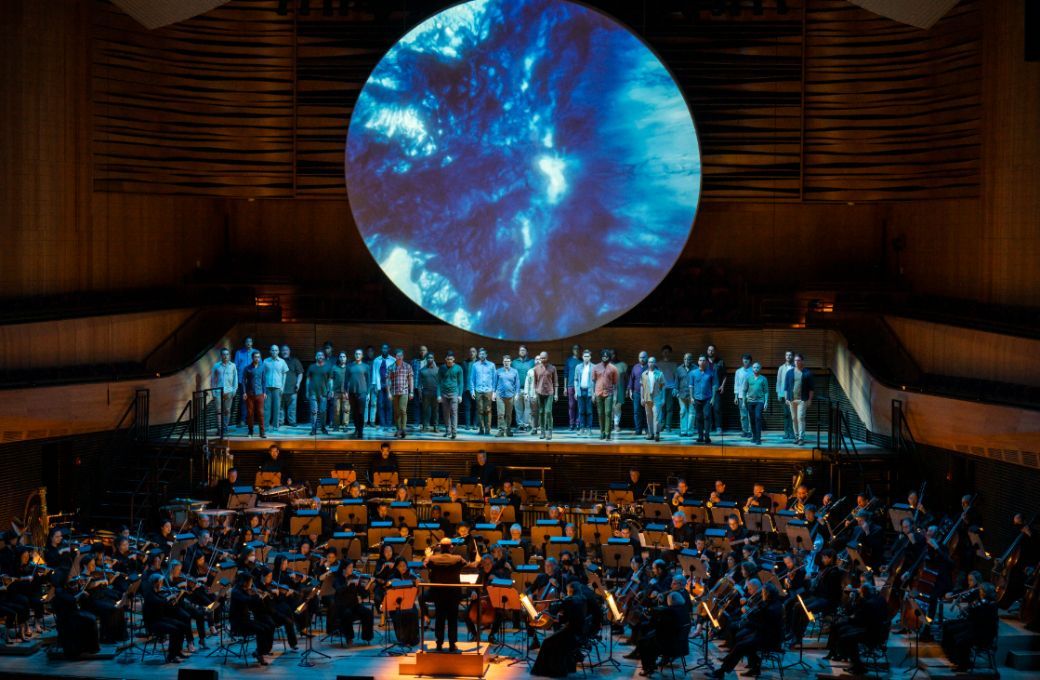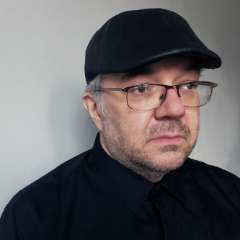A massive disc hung above the stage in the newly christened Wu Tsai Theater in Lincoln Center’s David Geffen Hall, reopened in October after extensive renovations, as the audience entered this concert. The orb hovered as an oversized talisman for the premiere by the New York Philharmonic under Jaap van Zweden of unEarth, a new work by composer, MacArthur Fellow and Bang on a Can co-founder Julia Wolfe, who is fast becoming one of America’s most important composers, like John Luther Adams with a sense of urgency. The disc’s soft, moon-like glow soon would be overtaken by stars, flowing water and a portrait of our planet.

Wolfe is, at times, such a literal composer that it’s a good thing she’s so good at infusing her orchestral pantomimes with genuine pathos, from the percussive scissors in the Pulitzer Prize winning Fire in my mouth (memorializing a deadly 1911 New York City sweatshop fire) to the percussion and guitar rainfall in this new work. Even the title, unEarth, is rather on-the-nose. But through it, Wolfe speaks truth, arising from the outset out of the mouths of babes. The composer interviewed members of the Young People’s Chorus of New York City (one of the two choirs in the premiere performance) regarding their thoughts about the climate crisis, and put excerpts alongside Biblical quotes and, later in the work, the word “tree” repeated in multiple languages, all with Carl Orff levels of drama.
Percussion was pronounced and compelling through the piece, with Wolfe supplanting the orchestra with chimes and gongs; caxixis, crotales, guiros and conga drums; marimba and vibraphone; and a full drum kit (as well as acoustic guitar, electric bass guitar and electric organ). Early on, the percussionists worked in precision like an off-kilter clock, counting down our remaining shared minutes (another instance of Wolfe prevailing with a device that could have fallen flat). As the piece progressed, the soundscape grew, through deft orchestration, in shifts and stair-steps.
The depth of Wolfe’s social concerns and the force of her musical sensibility make it all but impossible not to feel the weighty subjects she takes on. (Audience members were even given small houseplant starter kits as they left the theater after the concert.) The Forest movement, for example, with the male contingent of the vocal choir The Crossing repeatedly intoning the word “tree”, escaped trite minimalism and rose-tinted Disneyfication with beautiful layering of voices against fast percussion, the rest of the orchestra passing in and out of the mix. In the third and final section, Fix It, the men lined the stage with their backs to the audience to receive a message from soprano Else Torp, seemingly portraying Gaia. Hers was the only solo voice in the piece, and her sweeping glissandi and purring affirmation was actually enthralling.
It’s difficult to see a convection between Wolfe’s symphonic plea and the Sibelius concerto which opened the program without relying on the characterization of Nordic composers depicting their horizon, a motif routinely ascribed to SIbelius and Grieg up to Anna Thorvaldsdottir. The Violin Concerto is no landscape painting. It is, however, heavy with mood and demands a virtuosic soloist, a task to which Frank Huang rose admirably, negotiating a breakneck cadenza with the illusion of ease. The enormous orchestra built to a full gallop with a clarity that spoke to both its own ranks and its acoustically pristine new home.


